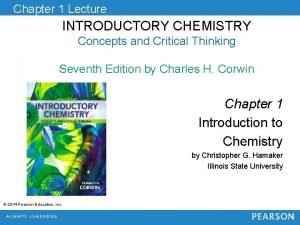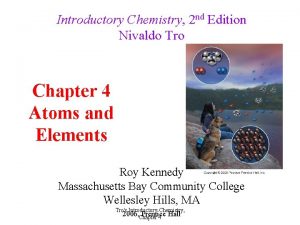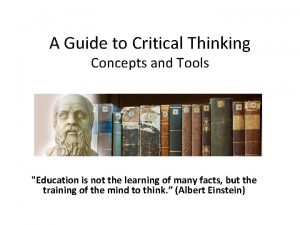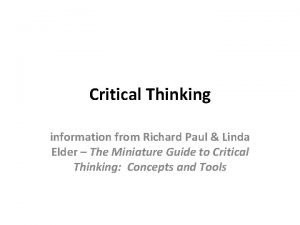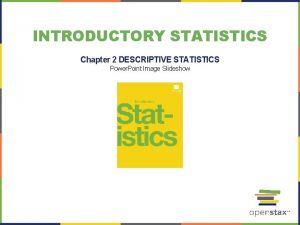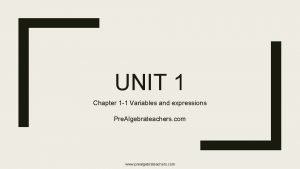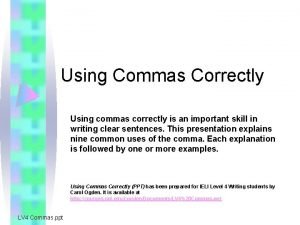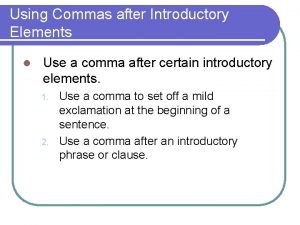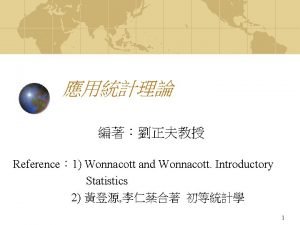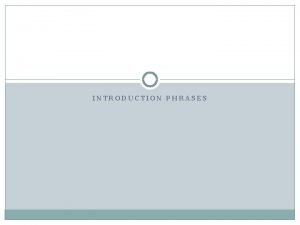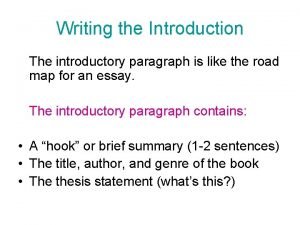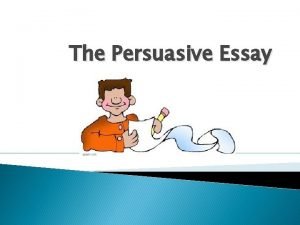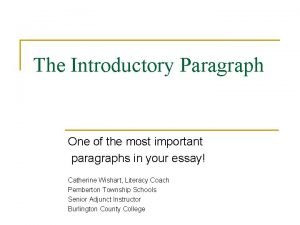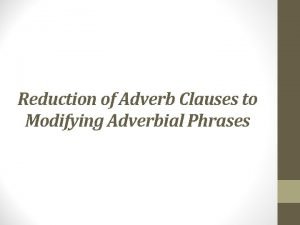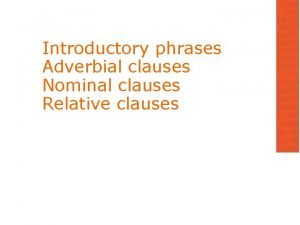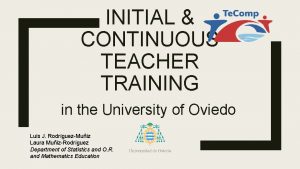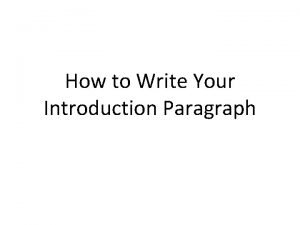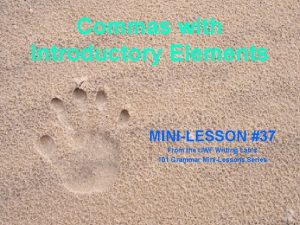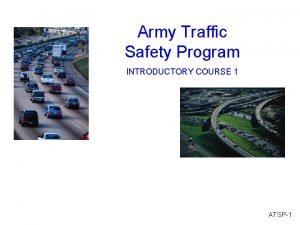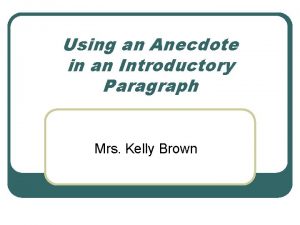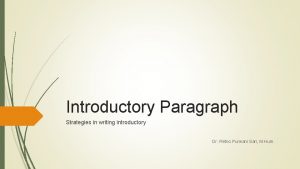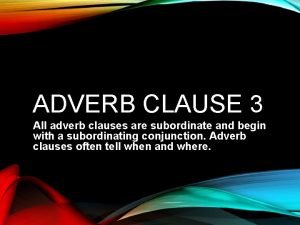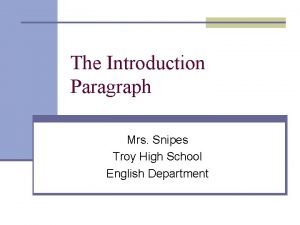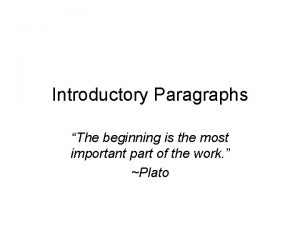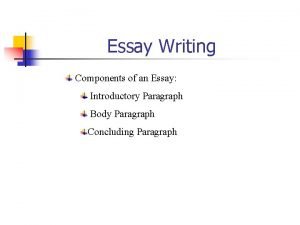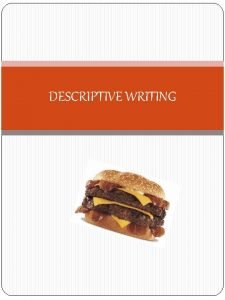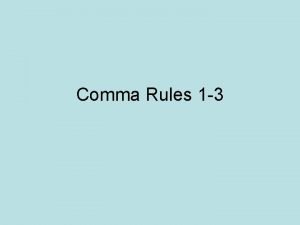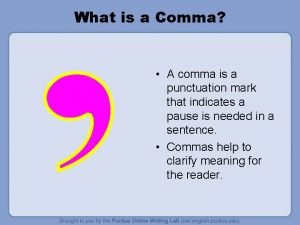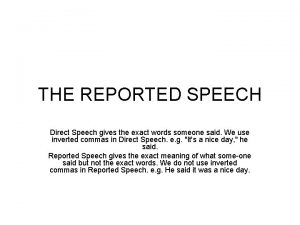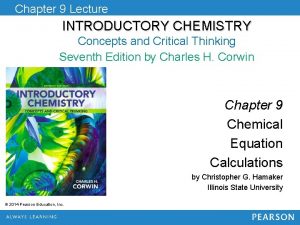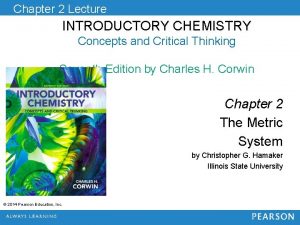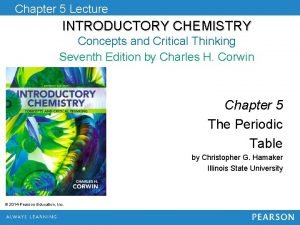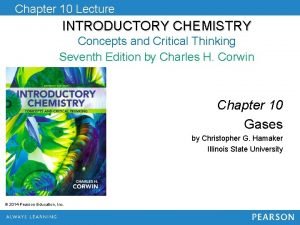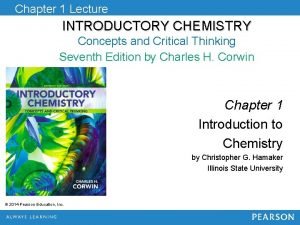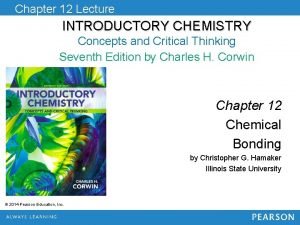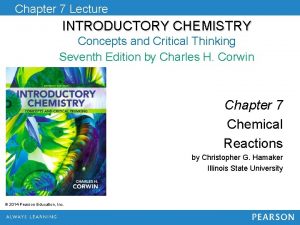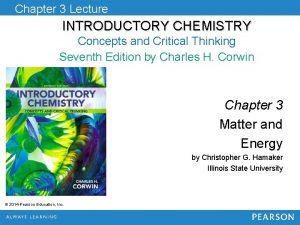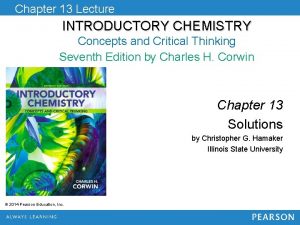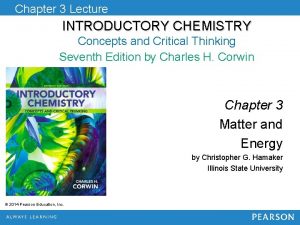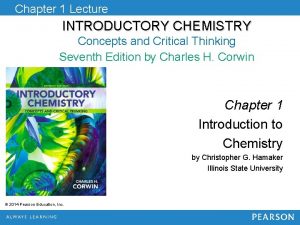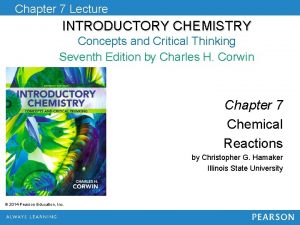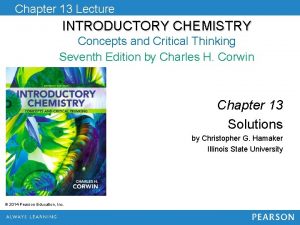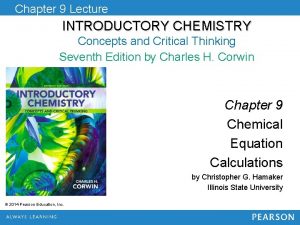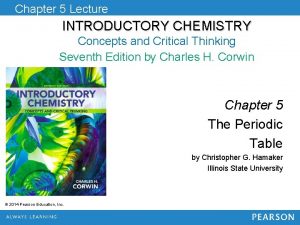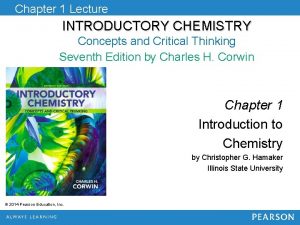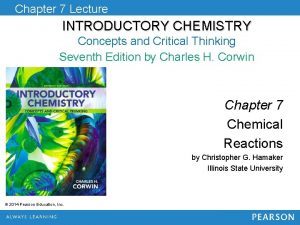Chapter 2 Lecture INTRODUCTORY CHEMISTRY Concepts and Critical






















































- Slides: 54

Chapter 2 Lecture INTRODUCTORY CHEMISTRY Concepts and Critical Thinking Seventh Edition by Charles H. Corwin Chapter 2 The Metric System by Christopher G. Hamaker Illinois State University © 2014 Pearson Education, Inc.

Basic Units and Symbols • The English system was used primarily in the British Empire. • The French organized a committee to devise a universal measuring system. • After about 10 years, the committee designed and agreed on the metric system. • The metric system offers simplicity with a single base unit for each measurement. © 2014 Pearson Education, Inc. Chapter 2

Metric System Basic Units © 2014 Pearson Education, Inc. Chapter 2

Original Metric Unit Definitions • A meter was defined as 1/10, 000 of the distance from the North Pole to the equator. • A kilogram (1000 grams) was equal to the mass of a cube of water measuring 0. 1 m on each side. • A liter was set equal to the volume of one kilogram of water at 4 C. © 2014 Pearson Education, Inc. Chapter 2

Metric Prefixes • The following table lists the common prefixes used in the metric system: © 2014 Pearson Education, Inc. Chapter 2

Metric Prefixes, Continued • For example, the prefix kilo- increases a base unit by 1000: – 1 kilogram is 1000 grams. • The prefix milli- decreases a base unit by a factor of 1000: – 1000 millimeters is 1 meter. © 2014 Pearson Education, Inc. Chapter 2

Metric Symbols • The names of metric units are abbreviated using symbols. Use the prefix symbol followed by the symbol for the base unit: – Kilometer is abbreviated km. – Milligram is abbreviated mg. – Microliter is abbreviated m. L. – Nanosecond is abbreviated ns. © 2014 Pearson Education, Inc. Chapter 2

Critical Thinking: The International System of Units (SI) • An advantage of the metric system (i. e. , International System of Units, SI) is that it is a decimal system. • It uses prefixes to enlarge or reduce the basic units. • For example: – A kilometer is 1000 meters. – A millimeter is 1/1000 of a meter. © 2014 Pearson Education, Inc. Chapter 2

Metric Conversion Factors • A unit equation relates two quantities that are equal. • For example: – 1 kilometer = 1000 meters – 1 km = 1000 m • Also, we can write: – 1 centimeter = 1/100 of a meter – 1 cm = 0. 01 m © 2014 Pearson Education, Inc. Chapter 2

Unit Factors • A unit conversion factor, or unit factor, is a ratio of two equivalent quantities. • For the unit equation 1 m = 100 cm, we can write two unit factors: 1 m 100 cm © 2014 Pearson Education, Inc. or Chapter 2 100 cm 1 m

Metric–Metric Conversions • An effective method for solving problems in science is the unit analysis method. • It is also often called dimensional analysis or the factor-label method. • There are three steps to solving problems using the unit analysis method. – Read the problem and determine the unit required in the answer. – Analyze the problem and determine the given value that is related to the answer. – Write one or more unit factors to convert the unit in the given value to the unit in the answer. © 2014 Pearson Education, Inc. Chapter 2

Applying the Unit Analysis Method © 2014 Pearson Education, Inc. Chapter 2

Metric Equivalents • We can write unit equations for the conversion between different metric units. • The prefix kilo- means 1000 basic units, so 1 kilometer is 1000 meters. • The unit equation is 1 km = 1000 m. • Similarly, a millimeter is 1/1000 of a meter, so the unit equation is 1000 mm = 1 m. © 2014 Pearson Education, Inc. Chapter 2

Metric Unit Factors • Since 1000 m = 1 km, we can write the following unit factors for converting between meters and kilometers: 1 km 1000 m or 1000 m 1 km • Since 1000 mm = 1 m, we can write the following unit factors: 1000 mm 1 m © 2014 Pearson Education, Inc. or Chapter 2 1 m. 1000 mm

Metric–Metric Conversion Problem What is the mass in grams of a 325 -mg aspirin tablet? • Step 1: We want grams. • Step 2: We write down the given: 325 mg. • Step 3: We apply a unit factor (1000 mg = 1 g) and round to three significant figures. 1 g 325 mg × = 0. 325 g 1000 mg © 2014 Pearson Education, Inc. Chapter 2

Two Metric–Metric Conversions A hospital has 125 deciliters of blood plasma. What is the volume in milliliters? • Step 1: We want the answer in m. L. • Step 2: We have 125 d. L. • Step 3: We need to first convert d. L to L and then convert L to m. L: 1 L and 1000 m. L 10 d. L 1 L © 2014 Pearson Education, Inc. Chapter 2

Two Metric–Metric Conversions, Continued • Apply both unit factors, and round the answer to three significant digits. • Notice that both d. L and L units cancel, leaving us with units of m. L. 1 L 1000 m. L × 125 d. L × = 12, 500 m. L 10 d. L 1 L © 2014 Pearson Education, Inc. Chapter 2

Another Example The mass of the Earth’s moon is 7. 35 × 1022 kg. What is the mass expressed in nanograms, ng? • We want ng; we have 7. 35 × 1022 kg. • Convert kilograms to grams, and then grams to nanograms. 6 ng 1000 g 1 × 10 × 7. 35 × 1022 kg × = 7. 35 × 1031 ng 1 kg 1 g © 2014 Pearson Education, Inc. Chapter 2

Metric–English Conversions • The English system is still very common in the United States. • We often have to convert between English and metric units. © 2014 Pearson Education, Inc. Chapter 2

Metric–English Conversions, Continued The length of an American football field, including the end zones, is 120 yards. What is the length in meters? • Convert 120 yd to meters (given that 1 yd = 0. 914 m). 0. 914 m 120 yd × = 110 m 1 yd © 2014 Pearson Education, Inc. Chapter 2

Metric–English Conversions, Continued A half-gallon carton contains 64. 0 fl oz of milk. How many milliliters of milk are in a carton? • We want m. L; we have 64. 0 fl oz. • Use 1 qt = 32 fl oz, and 1 qt = 946 m. L. 1 qt 946 m. L 64. 0 fl oz × × = 1, 890 m. L 32 fl oz 1 qt © 2014 Pearson Education, Inc. Chapter 2

Another English–Metric Problem A marathon is 26. 2 miles. What is the distance in kilometers (1 km = 0. 62 mi)? • Step 1: We want km. • Step 2: We write down the given: 26. 2 mi. • Step 3: We apply a unit factor (1 km = 0. 62 mi) and round to three significant figures. © 2014 Pearson Education, Inc. Chapter 2

Compound Units • Some measurements have a ratio of units. • For example, the speed limit on many highways is 55 miles per hour. How would you convert this to meters per second? • Convert one unit at a time using unit factors. 1. First, miles → meters 2. Next, hours → seconds © 2014 Pearson Education, Inc. Chapter 2

Compound Unit Problem A motorcycle is traveling at 105 km/hour. What is the speed in meters per second? • We have km/h; we want m/s. • Use 1 km = 1000 m and 1 h = 3600 s. 105 km 1000 m 1 hr × × = 29. 2 m/s 1 km hr 3600 s © 2014 Pearson Education, Inc. Chapter 2

Chemistry Connection: The Olympics • While the United States still uses English units of measure (mile, gallon, pounds), most of the rest of the world uses the metric system. • The distances in Olympic events are in metric units: 100 -m dash; 30 -km cross-country skiing; 3000 -m steeplechase. • The 1600 -m run is approximately 1 mile in length. © 2014 Pearson Education, Inc. Chapter 2

Critical Thinking: World Trade Center • When discussing measurements, it is critical that we use the proper units. • The World Trade Center footprint was 150 feet square, not 150 square feet. • NASA engineers mixed metric and English units when designing the Mars Climate Orbiter. – The engineers used kilometers rather than miles. – The spacecraft approached too close to the Martian surface and burned up in the atmosphere. © 2014 Pearson Education, Inc. Chapter 2

The Percent Concept • A percent, %, expresses the amount of a single quantity compared to an entire sample. • A percent is a ratio of parts per 100 parts. • The formula for calculating percent is shown below: © 2014 Pearson Education, Inc. Chapter 2

Calculating Percentages • Bronze is an allow of copper and tin. If a sample of bronze contains 79. 2 g of copper and 10. 8 g of tin, what is the percent copper in bronze? 79. 2 g × 100% = 88. 0% (79. 2 + 10. 8) g © 2014 Pearson Education, Inc. Chapter 2

Percent Unit Factors • A percent can be expressed as parts per 100 parts. • 25% can be expressed as 25/100 and 10% can be expressed as 10/100. • We can use a percent expressed as a ratio as a unit factor. – A rock is 4. 70% iron, so © 2014 Pearson Education, Inc. Chapter 2

Percent Unit Factor Calculation The Earth and Moon have a similar composition; each contains 4. 70% iron. What is the mass of iron in a lunar sample that weighs 92 g? • Step 1: We want g iron. • Step 2: We write down the given: 92 g sample. • Step 3: We apply a unit factor (4. 70 g iron = 100 g sample) and round to three significant figures. © 2014 Pearson Education, Inc. Chapter 2

Volume by Calculation • The volume of an object is calculated by multiplying the length (l) times the width (w) times the thickness (t). volume = l × w × t • All three measurements must be in the same units. • If an object measures 3 cm by 2 cm by 1 cm, the volume is 6 cm 3 (cm 3 is cubic centimeters). © 2014 Pearson Education, Inc. Chapter 2

Volumes of Solids, Liquids, and Gases • The liter (L) is the basic unit of volume in the metric system. • One liter is defined as the volume occupied by a cube that is 10 cm on each side. © 2014 Pearson Education, Inc. Chapter 2

Volumes of Solids, Liquids, and Gases, Continued • 1 liter is equal to 1000 cubic centimeters. – 10 cm × 10 cm = 1000 cm 3 • 1000 cm 3 = 1 L = 1000 m. L • Therefore, 1 cm 3 = 1 m. L © 2014 Pearson Education, Inc. Chapter 2

Cubic-Liquid Volume Conversion An automobile engine displaces a volume of 498 cm 3 in each cylinder. What is the displacement of a cylinder in cubic inches, in 3? • We want in 3; we have 498 cm 3. • Use 1 in = 2. 54 cm three times. 498 cm 3 1 in × × × = 30. 4 in 3 2. 54 cm © 2014 Pearson Education, Inc. Chapter 2

Volume by Displacement • If a solid has an irregular shape, its volume cannot be determined by measuring its dimensions. • You can determine its volume indirectly by measuring the amount of water it displaces. • This technique is called volume by displacement. • Volume by displacement can also be used to determine the volume of a gas. © 2014 Pearson Education, Inc. Chapter 2

Solid Volume by Displacement You want to measure the volume of an irregularly shaped piece of jade. • Partially fill a volumetric flask with water and measure the volume of the water. • Add the jade, and measure the difference in volume. • The volume of the jade is 10. 5 m. L. © 2014 Pearson Education, Inc. Chapter 2

Gas Volume by Displacement You want to measure the volume of gas given off in a chemical reaction. • The gas produced displaces the water in the flask into the beaker. The volume of water displaced is equal to the volume of gas. © 2014 Pearson Education, Inc. Chapter 2

The Density Concept • The density of an object is a measure of its concentration of mass. • Density is defined as the mass of an object divided by the volume of the object. mass = density volume © 2014 Pearson Education, Inc. Chapter 2

Density • Density is expressed in different units. It is usually grams per milliliter (g/m. L) for liquids, grams per cubic centimeter (g/cm 3) for solids, and grams per liter (g/L) for gases. © 2014 Pearson Education, Inc. Chapter 2

Densities of Common Substances © 2014 Pearson Education, Inc. Chapter 2

Estimating Density • We can estimate the density of a substance by comparing it to another object. • A solid object will float on top of a liquid with a higher density. • Object S 1 has a density less than that of water, but larger than that of L 1. • Object S 2 has a density less than that of L 2, but larger than that of water. © 2014 Pearson Education, Inc. Chapter 2

Calculating Density What is the density of a platinum nugget that has a mass of 224. 50 g and a volume of 10. 0 cm 3 ? Recall, density is mass/volume. 224. 50 g 3 = 22. 5 g/cm 10. 0 cm 3 © 2014 Pearson Education, Inc. Chapter 2

Density as a Unit Factor • We can use density as a unit factor for conversions between mass and volume. • An automobile battery contains 1275 m. L of acid. If the density of battery acid is 1. 84 g/m. L, how many grams of acid are in an automobile battery? – We have 1275 m. L; we want grams: 1. 84 g 1275 m. L × = 2350 g m. L © 2014 Pearson Education, Inc. Chapter 2

Temperature • Temperature is a measure of the average kinetic energy of individual particles in motion. • There are three temperature scales: 1. Fahrenheit 2. Celsius 3. Kelvin • Kelvin is the absolute temperature scale. © 2014 Pearson Education, Inc. Chapter 2

Temperature Scales • On the Fahrenheit scale, water freezes at 32 °F and boils at 212 °F. • On the Celsius scale, water freezes at 0 °C and boils at 100 °C. These are the reference points for the Celsius scale. • Water freezes at 273 K and boils at 373 K on the Kelvin scale. © 2014 Pearson Education, Inc. Chapter 2

Temperature Conversions • This is the equation for converting °C to °F. • This is the equation for converting °F to °C. • To convert from °C to K, add 273. °C + 273 = K © 2014 Pearson Education, Inc. Chapter 2

Fahrenheit-Celsius Conversions • Body temperature is 98. 6 °F. What is body temperature in degrees Celsius? In Kelvin? K = °C + 273 = 37. 0 °C + 273 = 310 K © 2014 Pearson Education, Inc. Chapter 2

The Heat Concept • Heat is a measure of total energy. • Temperature measures the average energy of particles in a system. • Heat is often expressed in terms of joules (J) or calories (cal). © 2014 Pearson Education, Inc. Chapter 2

Heat Versus Temperature • Although both beakers below have the same temperature (100 ºC), the beaker on the right has twice the amount of heat because it has twice the amount of water. © 2014 Pearson Education, Inc. Chapter 2

Specific Heat • The specific heat of a substance is the amount of heat required to raise the temperature of one gram of substance one degree Celsius. • It is expressed with units of calories per gram per degree Celsius. • The larger the specific heat, the more heat is required to raise the temperature of the substance. © 2014 Pearson Education, Inc. Chapter 2

Chapter Summary • The basic units in the metric system are grams for mass, liters for volume, and meters for distance. • The base units are modified using prefixes to reduce or enlarge the base units by factors of 10. • We can use unit factors to convert between metric units. • We can convert between metric and English units using unit factors. © 2014 Pearson Education, Inc. Chapter 2

Chapter Summary, Continued • A unit equation is a statement of two equivalent quantities. • A unit factor is a ratio of two equivalent quantities. • Unit factors can be used to convert measurements between different units. • A percent is the ratio of parts per 100 parts. © 2014 Pearson Education, Inc. Chapter 2

Chapter Summary, Continued • Volume is defined as length × width × thickness. • Volume can also be determined by displacement of water. • Density is mass divided by volume. © 2014 Pearson Education, Inc. Chapter 2

Chapter Summary, Continued • Temperature is a measure of the average energy of the particles in a sample. • Heat is a measure of the total energy of a substance. • Specific heat is a measure of how much heat is required to raise the temperature of a substance. © 2014 Pearson Education, Inc. Chapter 2
 Introductory chemistry concepts and critical thinking
Introductory chemistry concepts and critical thinking Critical semi critical and non critical instruments
Critical semi critical and non critical instruments Spaulding classification system
Spaulding classification system Introductory chemistry 4th edition
Introductory chemistry 4th edition Introductory chemistry 5th edition nivaldo j. tro
Introductory chemistry 5th edition nivaldo j. tro Introductory chemistry 5th edition nivaldo j. tro
Introductory chemistry 5th edition nivaldo j. tro Nivaldo j. tro introductory chemistry
Nivaldo j. tro introductory chemistry 01:640:244 lecture notes - lecture 15: plat, idah, farad
01:640:244 lecture notes - lecture 15: plat, idah, farad Well cultivated critical thinker
Well cultivated critical thinker Advanced inorganic chemistry lecture notes
Advanced inorganic chemistry lecture notes Lightning elves
Lightning elves Richard paul and linda elder
Richard paul and linda elder Introductory statistics chapter 2 answers
Introductory statistics chapter 2 answers Critical reading meaning
Critical reading meaning Variables and expressions 1-1 answer key
Variables and expressions 1-1 answer key Numerical expression
Numerical expression Formula for introduction paragraph
Formula for introduction paragraph Comma explanation
Comma explanation Commas after introductory phrases
Commas after introductory phrases Wonnacott and wonnacott introductory statistics pdf
Wonnacott and wonnacott introductory statistics pdf Introductory words and phrases signals
Introductory words and phrases signals Ib chemistry organic chemistry
Ib chemistry organic chemistry Inorganic vs organic chemistry
Inorganic vs organic chemistry Conclusion paragraph format
Conclusion paragraph format Introductory phrases examples
Introductory phrases examples Introductory paragraph for persuasive essay
Introductory paragraph for persuasive essay It is an introductory section of a news story
It is an introductory section of a news story Hook for intro paragraph
Hook for intro paragraph The desert paragraph
The desert paragraph Reduced adverbial clause
Reduced adverbial clause Www.atlasti.com
Www.atlasti.com Introductory paragraph literary analysis
Introductory paragraph literary analysis Introductory phrases
Introductory phrases Introduction paragraph examples
Introduction paragraph examples Advanced maxqda course
Advanced maxqda course Introductory paragraph
Introductory paragraph Introductory phrases examples
Introductory phrases examples Army traffic safety introductory course
Army traffic safety introductory course Anecdote example in essay
Anecdote example in essay Introductory rite
Introductory rite Introductory paragraph hook strategies
Introductory paragraph hook strategies Introductory paragraph examples
Introductory paragraph examples Introductory adverb clause
Introductory adverb clause Comma introductory clause
Comma introductory clause Snipes troy
Snipes troy Form content and use
Form content and use Performance review institute inc
Performance review institute inc Seed paragraph
Seed paragraph Introductory elements examples
Introductory elements examples General statement
General statement Basic essay and paragraph format
Basic essay and paragraph format As well as comma
As well as comma Introductory rites clipart
Introductory rites clipart What is an introductory clause
What is an introductory clause Askwonder
Askwonder
